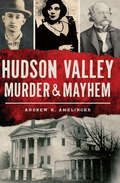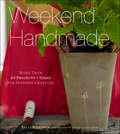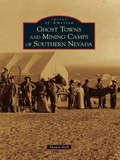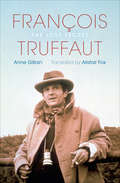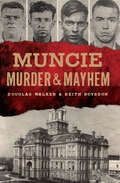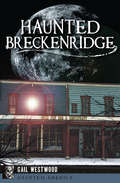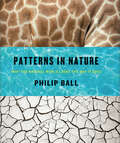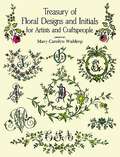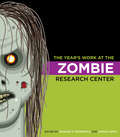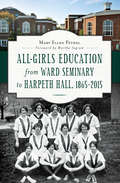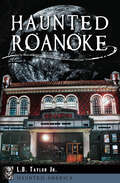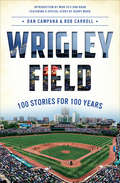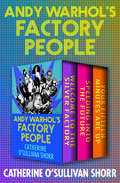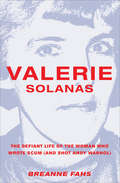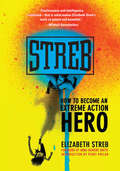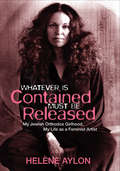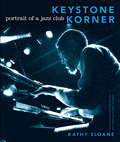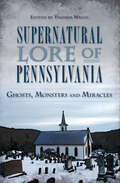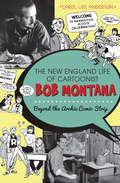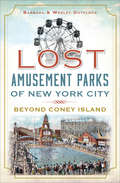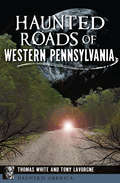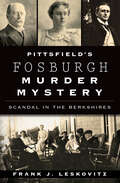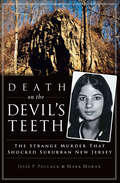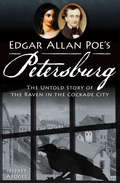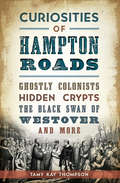- Table View
- List View
Hudson Valley Murder & Mayhem (Murder And Mayhem Ser.)
by Andrew K. AmelinckxThe Hudson Valley&’s dark past, from Prohibition-era shoot-outs to unsolved murders, in eleven heart-pounding true stories. The beautiful Hudson Valley of New York State is drenched in history, culture . . . and blood. This fascinating and thoroughly researched chronicle presents one killer story from every county in the region, including: Sullivan County: In the fall of 1893, Lizzie Halliday left a trail of bodies in her wake, slaughtering two strangers and her husband before stabbing a nurse to death at the asylum where she lived. Albany County: A Jazz Age politician, tired of fighting with his overbearing wife, murdered her and buried the body under the front porch. Columbia County: In 1882, a cantankerous old miner, dubbed the &“Austerlitz Cannibal&” by the press, chopped up his partner before he himself swung from the end of a rope.
Weekend Handmade: More Than 40 Projects and Ideas for Inspired Crafting (Weekend Craft Ser.)
by Kelly Wilkinson&“Weekend Handmade provides instructions for quirky crafts that virtually anyone can do . . . Think hipster Martha Stewart&” (NPR Weekend Edition). In Weekend Handmade, author Kelly Wilkinson encourages readers to celebrate the joy of crafting, both for the satisfaction of making something by hand, and because the finished items serve as reminders of time taken to slow down and create—no matter the day of the week. The book is organized into three sections: &“Make&” offers projects to wear or decorate with; &“Grow&” presents projects inspired by gardens, fields, and farmer&’s markets; and &“Gather&” spotlights projects that enrich casual get-togethers. With clear, step-by-step instructions, every project in Weekend Handmade—from aprons, tablecloths, and marmalade to a memory box and a chandelier—can be completed in a few hours or over the course of a weekend. &“Think you can&’t make anything—or, more importantly, that you don&’t have the time to? Wilkinson&’s undowdy projects—luminarias, table decorations—are all designed to be completed in a couple of hours.&” —Entertainment Weekly
Ghost Towns and Mining Camps of Southern Nevada (Images of America)
by Shawn Hall&“[A] photo-packed look at Southern Nevada&’s boom-and-bust civic casualties&” (Las Vegas Review-Journal). Ghost towns and mining camps are the last remaining vestiges of the Old West; there is a mystique surrounding these places that has made exploring them a pastime for many in the western United States. Nevada has more than a thousand of these boom-and-bust towns. Some are completely abandoned, while some still struggle to survive and even serve as county seats. Sadly, these wonderful places, including those covered in this volume, are constantly in danger from vandalism and neglect. Many ghost towns and mining camps have been destroyed or damaged needlessly, and those who are captivated by their charm must protect these windows into history so that they survive for future generations. Includes photos! &“Few folks know as much about Nevada ghost towns as author Shawn Hall.&” —Nevada Appeal
François Truffaut: The Lost Secret
by Anne Gillain&“Truffaut fans will love this English translation of Gillain&’s work drawing on the psychology and cinematography of the acclaimed filmmaker.&” —Booklist For François Truffaut, the lost secret of cinematic art is in the ability to generate emotion and reveal repressed fantasies through cinematic representation. Available in English for the first time, Anne Gillain&’s François Truffaut: The Lost Secret is considered by many to be the best book on the interpretation of Truffaut&’s films. Taking a psycho-biographical approach, Gillain shows how Truffaut&’s creative impulse was anchored in his personal experience of a traumatic childhood that left him lonely and emotionally deprived. In a series of brilliant, nuanced readings of each of his films, she demonstrates how involuntary memories arising from Truffaut&’s childhood not only furnish a succession of motifs that are repeated from film to film, but also govern every aspect of his mise en scène and cinematic technique. &“Brilliant . . . A delicious reexamination . . . that will make us want to sit down and take in all of Truffaut&’s wonderful filmography at once.&” —PopMatters
Muncie Murder & Mayhem (Murder And Mayhem Ser.)
by Douglas Walker Keith RoysdonThe authors of Wicked Muncie tell the city&’s lurid history in the true stories of its most infamous criminals and the lawmen who brought them down. Muncie epitomizes the small-town America of squeaky-clean 1950s sitcoms, but its wholesome veneer conceals a violent past. Public scandals and personal tragedy dogged the long, notorious life of Dr. Jules LaDuron. Baseball ace Obie McCracken met a tragic and violent end after joining the police force. A mother&’s love could not stop James Hedges from committing murder. The paranoid delusions of Leonard Redden hounded him until one day he carried a shotgun into a quiet classroom. Detectives Melvin Miller and Ambrose Settles chased a murderer across county lines in pursuit of justice. And newsman George Dale&’s showdown with the Klan prepared him for the political fight of his life. Douglas Walker and Keith Roysdon, authors of Wicked Muncie, introduce a new cast of characters from the city's notorious past. Includes photos!
Haunted Breckenridge (Haunted America)
by Gail WestwoodGhostly tales of Colorado&’s colorful—and chilling—past . . . photos included! From the old gold-mining towns of Summit County to skiing destinations in Breckenridge, eerie and true tales of life and loss in the Wild West abound in this corner of Colorado. The spirit of mutilated miner William Goodwin is said to haunt Blue River, warning of the dangers lurking below. Some say that the ghost of the widow Sylvia, who died destitute and alone at a boarding house on Main Street, still haunts the building today. Coldblooded killer Dr. Condon took revenge on his stalker and killed the town&’s favorite barkeeper. In this fascinating book, tour guide and author Gail Westwood explores the area&’s most haunted buildings and introduces the ghastly characters who seemingly never left.
Patterns in Nature: Why the Natural World Looks the Way It Does
by Philip BallThe acclaimed science writer &“curates a visually striking, riotously colorful photographic display…of physical patterns in the natural world&” (Publishers Weekly, starred review). Though at first glance the natural world may appear overwhelming in its diversity and complexity, there are regularities running through it, from the hexagons of a honeycomb to the spirals of a seashell and the branching veins of a leaf. Revealing the order at the foundation of the seemingly chaotic natural world, Patterns in Nature explores not only the math and science but also the beauty and artistry behind nature&’s awe-inspiring designs. Unlike the patterns we create, natural patterns are formed spontaneously from the forces that act in the physical world. Very often the same types of pattern and form—such as spirals, stripes, branches, and fractals—recur in places that seem to have nothing in common, as when the markings of a zebra mimic the ripples in windblown sand. But many of these patterns can be described using the same mathematical and physical principles, giving a surprising unity to the kaleidoscope of the natural world. Richly illustrated with 250 color photographs and anchored by accessible and insightful chapters by esteemed science writer Philip Ball, Patterns in Nature reveals the organization at work in vast and ancient forests, powerful rivers, massing clouds, and coastlines carved out by the sea. By exploring similarities such as the branches of a tree and those of a river network, this spectacular visual tour conveys the wonder, beauty, and richness of natural pattern formation.
Treasury of Floral Designs and Initials for Artists and Craftspeople (Dover Pictorial Archive)
by Mary Carolyn WaldrepYou'll find a thousand different uses for this practical archive of royalty-free designs with a floral theme. It includes over 700 wonderfully graceful and imaginative designs featuring flowers, leaves, and vines in delicate interlacements. Most incorporate elaborately embellished letters, initials, monograms, and names.Needleworkers, fabric painters, and other craftworkers will love browsing through these pages for the perfect design to personalize towels, handkerchiefs, bed linens, clothing, and more. Textile designers, graphic artists, and calligraphers will also find the volume brimming with useful ideas and models for creating rich floral designs, illustrated letters, borders, and frames.
The Year's Work at the Zombie Research Center (The Year's Work: Studies in Fan Culture and Cultural Theory)
by John Gibson Stephen Schneider Jonathan P. Eburne Stephen Shapiro Dan Hassler-Forest Andrea Ruthven Stephen Watt Tatjana Soldat-Jaffe Atia Sattar Seth Morton Erik Bohman Jack Raglin&“Playful and (un)deadly serious . . . chew[s] through a near-exhaustive array of films, television, literature, culture, music and even cocktails.&”—Times Literary Supplement They have stalked the horizons of our culture, wreaked havoc on moribund concepts of dead and not dead, threatened our sense of identity, and endangered our personal safety. Now zombies have emerged from the lurking shadows of society&’s fringes to wander the sacred halls of the academy, feasting on tender minds and hurling rot across our intellectual landscape. It is time to unite in common cause, to shore up defenses, firm up critical and analytical resources, and fortify crumbling lines of inquiry. Responding to this call, Brain Workers from the Zombie Research Center poke and prod the rotting corpus of zombie culture trying to make sense of cult classics and the unstoppable growth of new and even more disturbing work. They exhume &“zombie theory&” and decaying historical documents from America, Europe, and the Caribbean in order to unearth the zombie world and arm readers with the brain tools necessary for everyday survival. Readers will see that zombie culture today &“lives&” in shapes as mutable as a zombie horde—and is often just as violent. &“An intelligent and highly engaging collection that will appeal to legions of zombie fans, to students in the humanities, and to scholars working in fields that have already been affected by or are now preparing for the zombie apocalypse. It blends entertaining, illuminating, and accessible readings of zombies and zombie culture with unique interventions made from authoritative positions of expertise.&”—Julian Murphet, author of Faulkner&’s Media Romance
All-Girls Education from Ward Seminary to Harpeth Hall, 1865–2015: 1865-2015
by Mary Ellen PethelThe history behind one of the oldest all-girls prep schools in the South. During the final days of the Civil War, Dr. William Ward and his wife, Eliza Ward, envisioned a school for young women in Nashville that would evolve into one of the nation&’s most prestigious institutions. As the New South dawned, Ward Seminary opened its doors in September 1865. Merging with Belmont College for Young Women in 1913, Ward-Belmont operated as a college preparatory school, music conservatory, and junior college. In 1951, the high school division moved farther west, reopening as the Harpeth Hall School after Ward-Belmont&’s sudden closure. Ward Seminary, Belmont College, Ward-Belmont, and Harpeth Hall are simply separate chapters of one continuous story—providing a lens through which to understand the evolution of all-girls education in the United States.
Haunted Roanoke (Haunted America)
by L.B. Taylor Jr.The author of The Big Book of Virginia Ghost Stories focuses on the &“Scare City&”: &“If you believe in ghosts, this is the book for you&” (The Roanoke Times). Roanoke, in the heart of southwestern Virginia, is one of the most haunted cities in the commonwealth. The Star City is brimming with eerie and unexplainable stories, such as the legendary &“Woman in Black,&” who appeared several times in 1902, but only to married men on their way home at night. There are also macabre stories in many of Roanoke&’s famous landmarks, such as the majestic Grandin Theatre, where a homeless family is said to have lived—and the cries of their deceased children can still be heard. Travel beyond the realm of reality with author L.B. Taylor Jr. as he traces the history of Roanoke&’s most unique and chilling tales. Includes photos! &“I like the ghost story books of L.B. Taylor, Jr., a Virginia author, because he blends history and true ghost stories so wonderfully. He doesn&’t make judgments about each ghost story, but presents the facts and lets you decide for yourself. . . . So if you&’re in a ghostly mood this October—or if you&’re just a history lover—Taylor&’s books are well worth your time.&” —Eagle-Eyed Editor
Wrigley Field: 100 Stories for 100 Years (Sports Ser.)
by Rob Carroll Dan CampanaA collection of stories, photos, and memories for those who love the Chicago Cubs&’ legendary ballpark. Wrigley Field occupies a sacred space in the hearts of Cubs fans and in the soul of Wrigleyville. With contributions from those in the stands, on the field, and behind the scenes over the years—among them Bob Costas, Rick Sutcliffe, Ferguson Jenkins, Steve Stone, and many more—this informal oral history salutes the legacy that has made Wrigley such an unforgettable part of baseball and Chicago for the last century. These one hundred stories reflect the variety of millions of Cubs fans around the world, from those whose relationship with the Friendly Confines has lasted a lifetime to those who are taking their seats up close to the ivy for the very first time.
Andy Warhol's Factory People: Welcome to the Silver Factory, Speeding into the Future, and Your Fifteen Minutes Are Up (Andy Warhol's Factory People #2)
by Catherine O'Sullivan ShorrBased on the television documentary: A three-part oral history of the Pop Art sensation&’s inner circle and their dazzling world of art, drugs, and drama. Featuring a new introduction by the author, special to this collection, this three-part companion volume to Emmy Award–winning Catherine O&’Sullivan Shorr&’s documentary Andy Warhol&’s Factory People is an unprecedented exposé of an exhilarating and tumultuous time in the 1960s New York City art world—told by the artists, actors, writers, musicians, and hangers-on who populated and defined the Factory. &“Different [in] its avowed bottom-up approach: Warhol as a function of his followers is the idea. This time . . . it&’s the interviews that tell the tale&” (Robert Lloyd, Los Angeles Times). Welcome to the Silver Factory: In 1962, frustrated with advertising work, Warhol sets up his legendary studio in an abandoned hat factory on Manhattan&’s 47th Street. The &“Silver Factory&” quickly becomes the hub of Warhol&’s creative endeavors—the space where he constantly works while an ever-changing cast of characters and muses passes through with their own contributions. Speeding into the Future: In a peak period from 1965 through 1966, Warhol creates the notion of the &“It Girl&” with ingenuous debutante Edie Sedgwick; discovers Lou Reed, the Velvet Underground, and Nico, the gorgeous chanteuse who becomes his next &“It Girl&”; and directs—with Paul Morrissey—his most commercially successful film, the art house classic, Chelsea Girls. Your Fifteen Minutes Are Up: By 1967, it seems that the Factory has outlived its fifteen minutes of fame. Superstars like Edie Sedgwick fall victim to drugs. Factory denizens have falling-outs with Warhol, as do the Velvet Underground, who are also caught up in disputes of their own. Into the chaos comes radical feminist Valerie Solanas, who shoots Warhol and seriously injures him. He survives—barely—but the artist, and his art, are forever changed.
Valerie Solanas: The Defiant Life of the Woman Who Wrote Scum (and Shot Andy Warhol)
by Breanne FahsThe authoritative biography of the 60s countercultural icon who wrote SCUM Manifesto, shot Andy Warhol, and made an unforgettable mark on feminist history. Valerie Solanas is one of the most polarizing figures of 1960s counterculture. A cult hero to some and vehemently denounced by others, she has been dismissed but never forgotten. Known for shooting Andy Warhol in 1968 and for writing the infamous SCUM Manifesto, Solanas became one of the most famous women of her era. But she was also diagnosed with paranoid schizophrenia and spent much of her life homeless or in mental hospitals. Solanas&’s SCUM Manifesto, a sui generis vision of radical gender dystopia, predicted ATMs, test-tube babies, the Internet, and artificial insemination long before they existed. It has sold more copies and been translated into more languages than nearly all other feminist texts of its time. And yet, shockingly little work has investigated the life of its author. This book is the first biography about Solanas, including original interviews with family, friends (and enemies), and numerous living Warhol associates. It reveals surprising details about Solanas&’s life: the children nearly no one knew she had, her drive for control over her own writing, and her elusive personal and professional relationships. Valerie Solanas reveals the tragic, remarkable life of an iconic figure. It is &“not only a remarkable biographical feat but also a delicate navigation of an unwieldy, demanding, and complex life story&” (BOMB Magazine).
Streb: How to Become an Extreme Action Hero
by Elizabeth StrebAn inspiring memoir and self-help guide to greatness by the dancer Mikhail Baryshnikov calls &“fearlessness and intelligence combined . . . potent and beautiful.&” Called &“the Evel Knievel of Dance,&” Elizabeth Streb has been pushing boundaries and testing the potential of the human body since childhood. Can she fly? Can she run up walls? Can she break through glass? How fast can she go? With clarity and humor—and with her internationally-renowned dance troupe STREB—she continues to investigate what movement truly is and has come to these conclusions: It&’s off the ground! It creates impact! And it hurts trying to stop! Here, Streb combines memoir and analysis to convey how she became an extreme action dancer and choreographer, developing a form of movement that&’s more NASCAR than modern dance, more boxing than ballet, and more than most people can handle &“in this dizzying, inspirational self-help&” books (Publishers Weekly, starred review).
Whatever Is Contained Must Be Released: My Jewish Orthodox Girlhood, My Life as a Feminist Artist (Jewish Women Writers Ser.)
by Helène Aylon&‘[A] richly evocative, captivating, and reflective memoir&” of a feminist artist who broke free of the limits placed on her by family, Judaism and society (Publishers Weekly). Growing up an Orthodox Jew in Brooklyn, Helene Aylon spent her Friday nights in a sea of extended family as the Sabbath candles flickered. Passionate about art, she dreamt of escaping the strict, secular world of her youth, but instead married a rabbi and became a mother of two. Then, her world was split apart when her husband was diagnosed with cancer, and Aylon found herself widowed at thirty. Free to explore both her own soul and the changing world around her, Aylon sought a home in the burgeoning environmental art scene of the 1970s—creating transgressive works that explore identity, women&’s bodies, the environment, disarmament, and the notion of God. Finally, she dares to asks of Judaism: Where are the women? With many examples of her work included within, Whatever is Contained &”is an arresting tale of uncommon courage, intelligence, and wit&” following Aylon&’s search for truth in art, and the links between feminism and Judaism (Gail Levin, author of Lee Krasner: A Biography and Becoming Judy Chicago).
Keystone Korner: Portrait of a Jazz Club
by Kathy SloaneThe award-winning photographer&’s pictorial history of the famous San Francisco Jazz club featuring oral histories and more than 100 images—&“A treasure&” (SF Weekly). In the words of Wynton Marsalis, &“Keystone Korner was the quintessential jazz club . . . a happy home to people of all persuasions.&” During the 1970s, when jazz clubs across America were folding under the onslaught of rock and roll and disco, San Francisco&’s Keystone Korner was an oasis for jazz listeners and musicians. Tucked away in the city&’s North Beach area, the Keystone became one of the most important jazz spots in the United States. It was so beloved by musicians that superstars McCoy Tyner, Freddie Hubbard, Ron Carter, and Elvin Jones played a benefit concert to raise money for its liquor license. In this book, award-winning photographer Kathy Sloane shares more than 100 black and white photographs documenting the musicians and regulars, the spontaneous moments and ephemeral scene of this legendary club. Together with these images, she has compiled a fascinating collage of first-hand oral histories that chronicle the Keystone experience. &“From the antics of the photo-laden backroom to the underground hype of Ora Harris&’ Keystone Kitchen, Sloane and fellow editor Sascha Feinstein leave no stone unturned. They examine the backstories of some of Keystone&’s most lovable characters . . . a delightful sensory overload&” (Downbeat).
Supernatural Lore of Pennsylvania: Ghosts, Monsters and Miracles (American Legends Ser.)
by Thomas WhiteLocal legends and paranormal mysteries of Pennsylvania—photos included. Strange creatures and tales of the supernatural thrive in Pennsylvania, from ghostly children who linger by their graves to werewolves that ambush nighttime travelers. Passed down over generations, Keystone State legends and lore provide both thrilling stories and dire warnings. Phantom trains chug down the now removed rails of the P&LE Railroad line on the Great Allegheny Passage. A wild ape boy is said to roam the Chester swamps, while the weeping Squonk wanders the hemlock-shrouded hills of central Pennsylvania, lamenting his hideousness. On dark nights, the ghosts of Betty Knox and her Union soldier beau still search for each other at Dunbar Creek. Join Thomas White and company as they go in search of the truth behind the legends of supernatural Pennsylvania.
The New England Life of Cartoonist Bob Montana: Beyond the Archie Comic Strip
by Carol Lee AndersonThe true story of the artist whose high school years in Massachusetts inspired Riverdale. Bob Montana, creator of the Archie comic strip and one of America&’s greatest cartoonists, always considered himself a true New Englander. Filled with the antics of the rambunctious teenagers of the fictional Riverdale High, Montana&’s comic strip was based on his high school years in Haverhill, Massachusetts. At the height of his career, he lived as a beloved resident in the quaint, picturesque town of Meredith in the heart of the Lakes Region of New Hampshire. For nearly thirty years, he was considered an extraordinarily respected contributor to the community. Drawing from the Yankee humor he saw around him, Montana deftly included local scenes, events, and characters in the puns and pranks of Archie&’s comic-strip life. Join Lakes Region historian Carol Lee Anderson as she takes readers beyond the comic strip and tells the story of the remarkable New England life of Bob Montana.
Lost Amusement Parks of New York City: Beyond Coney Island (Lost Ser.)
by Wesley Gottlock Barbara GottlockA historical tour of fun and frolic in the five boroughs—including photos from the good old days. Coney Island is an iconic symbol of turn-of-the-century New York—but many other amusement parks have thrilled the residents of the five boroughs. Strategically placed at the end of trolley lines, railways, public beaches, and waterways, these playgrounds for the rich and poor alike first appeared in 1767. From humble beginnings, they developed into huge sites like Fort George, Manhattan&’s massive amusement complex. Each park was influenced by the culture and eclectic tastes of its owners and patrons—from the wooden coasters at Staten Island&’s Midland Beach to beer gardens on Queens&’ North Beach and fireworks blasting from the Bronx&’s Starlight Park. As real estate became more valuable, these parks disappeared. With this historical tour, you can rediscover the thrills of the past from the lost amusement parks of New York City.
Haunted Roads of Western Pennsylvania (Haunted America)
by Thomas White Tony LavorgneThe twisty roads—and twisted tales—of the Appalachian Mountains make for distracted driving in western Pennsylvania. Ghostly travelers are said to wander the lonely roads of western Pennsylvania. A creeping fog rises from Blue Mist Road, and stories of car crashes, lynchings and even strange beasts haunt this isolated stretch outside Pittsburgh. Is it the angry spirit of a jealous husband or a gypsy king who stalks Erie County&’s Axe Murder Hollow? Shades of Death Road in Washington County may be host to phantom coal miners killed during a deadly labor dispute. With firsthand accounts and historical research, authors Thomas White and Tony Lavorgne travel the backcountry roads and byways of western Pennsylvania to discover their ghost tales and mysterious legends. Includes photos! &“The authors include a history of each road along with the supernatural legends and other unexplained activity. Surprisingly, they are able to provide possible explanations for most of the alleged hauntings, but admit that they cannot account for every one, which allows the roads in question to keep their allure and spooky possibilities.&” —PopCultureGuy
Pittsfield's Fosburgh Murder Mystery: Scandal in the Berkshires (True Crime Ser.)
by Frank J. LeskovitzA riveting account of one of the most scandalous unsolved murders at the turn of the nineteenth century: the killing of twenty-four-year-old May Fosburgh. Shots rang out in a prominent Pittsfield family home on the morning of August 20, 1900, ending the life of young socialite May Fosburgh. Who pulled the trigger was unclear, and the scandal captivated attention well beyond the Berkshires. Her brother was a top suspect, but the distraught family claimed an intruder was to blame. Investigators, media and the public struggled to make sense of conflicting details, including suspicious gunpowder residue, as the mystery remained unsolved. Author Frank J. Leskovitz unravels the tale that still lingers in the hills generations later. Includes photos! &“A clear, thorough account of this old crime . . . The book respects the dead but also respects the interest readers take in the past.&” —Greenfield Recorder
Death on the Devil's Teeth: The Strange Murder That Shocked Suburban New Jersey (True Crime Ser.)
by Mark Moran Jesse P. PollackRumors, witchcraft, and murder in this true crime account of one of New Jersey&’s most notorious cold cases—from two Weird N.J. magazine contributors. As Springfield residents decorated for Halloween in September 1972, the crime rate in the affluent New Jersey township was at its lowest in years. That mood was shattered when the body of sixteen-year-old Jeannette DePalma was discovered in the woods, allegedly surrounded by strange objects. Some feared witchcraft was to blame, while others believed a serial killer was on the loose. Rumors of a police coverup ran rampant, and the case went unsolved—along with the murders of several other young women. Including extensive interviews with DePalma&’s friends and family, new evidence, and theories about who could have committed this horrible crime, Death on the Devil&’s Teeth provides the definitive account of this shocking cold case more that remains a mystery more than four decades later.
Edgar Allan Poe's Petersburg: The Untold Story of the Raven in the Cockade City
by Jeffrey AbugelVisit the Virginia city where the great author brought his thirteen-year-old bride for a honeymoon. Antebellum Petersburg was a melting pot of French, Haitian, Scotch-Irish, and free black populations. It was in this eclectic city that the master of the macabre, Edgar Allan Poe, chose to take his new wife, thirteen-year-old first cousin Virginia Clemm, on their honeymoon in 1836. This book traces the steps of the controversial couple through imaginative scenes of historic Petersburg. From Poe&’s own mother performing in the local venues to the poet&’s lasting friendship with Petersburg native and publisher Hiram Haines, it reveals an overlooked moment in the young life of this literary giant. Includes photos
Curiosities of Hampton Roads: Ghostly Colonists, Hidden Crypts, the Black Swan of Westover, and More
by Tamy Kay ThompsonFacts and photos highlighting the haunting side of Virginia&’s Tidewater . . . The history of Hampton Roads is as deep as the waters that surround it. From some of the first settlers in the New World to the formation of the nation, Virginia&’s Tidewater is rich in curious tales of legends and lore. In the Southside, the famed pirate Blackbeard was beheaded by Captain Maynard of Hampton. Captain John Smith was a part of the first governing body in America formed in Jamestown. The nation&’s oldest mental institution still stands in Williamsburg. Staff and guests at Boxwood Inn in Newport News have reported hauntings from a former owner and other eerie occurrences. In this offbeat travel guide, author Tamy Kay Thompson covers these stories and more as she takes readers on a journey through the always entertaining past of Hampton Roads.
